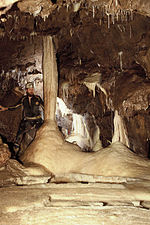Stoke Lane Slocker
Caves of the Mendip HillsLimestone caves

Stoke Lane Slocker (grid reference ST66874745) is a cave near Stoke St Michael, in the Carboniferous Limestone of the Mendip Hills, in the English county of Somerset. It is 2.18 km in length and reaches a depth of 30m.It was previously known as Stoke Lane Swallet, but now the local name is preferred. The origin of the word "Slocker" is obscure, possibly from "slock" meaning to entice or lure away although the Gaelic word for swallow hole is "sluighaire".
Excerpt from the Wikipedia article Stoke Lane Slocker (License: CC BY-SA 3.0, Authors, Images).Stoke Lane Slocker
Bector Lane, Mendip Stoke St Michael
Geographical coordinates (GPS) Address External links Nearby Places Show on map
Geographical coordinates (GPS)
| Latitude | Longitude |
|---|---|
| N 51.22527 ° | E -2.47581 ° |
Address
Stoke Lane Slocker
Bector Lane
BA3 5WP Mendip, Stoke St Michael
England, United Kingdom
Open on Google Maps






